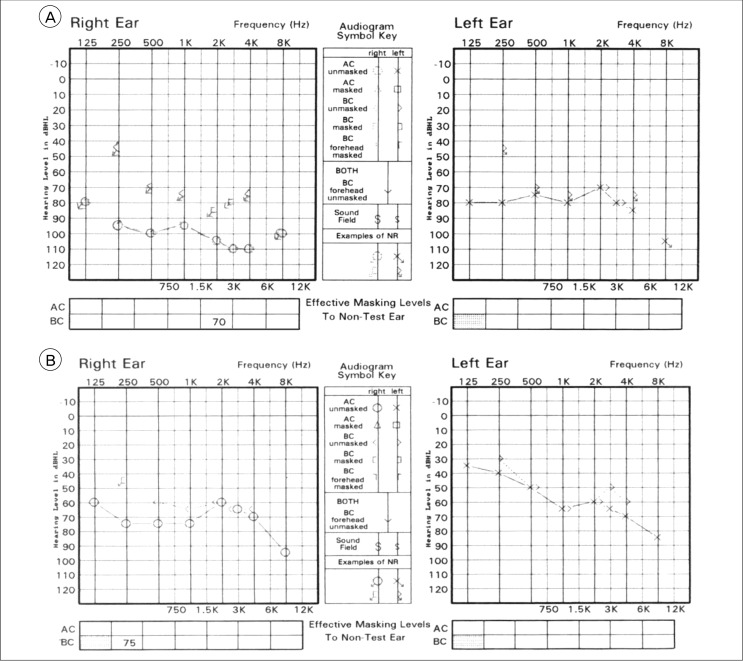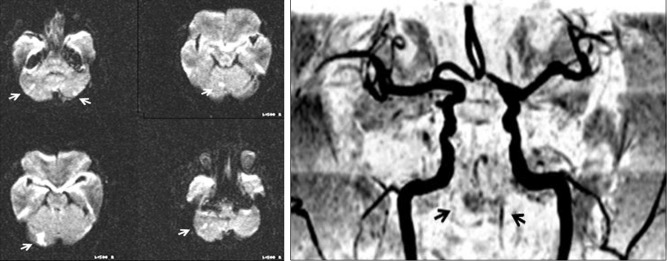Abstract
Isolated bilateral deafness is a rare but possible symptom of vertebrobasilar ischemia, primarily due to occlusion of the anterior inferior cerebellar arteries or their branch, the internal auditory artery. We reported on uncommon case of sudden bilateral sensorineural hearing loss without typical neurological symptoms resulting from vertebrobasilar ischemia. We performed the available examinations, including otoscopy, laboratory tests, and pure tone audiogram, however we were not able to identify the cause of bilateral sensorineural hearing loss. Brain magnetic resonance image showed the cerebellar infarction of the posterior inferior cerebellar artery territory. Brain magnetic resonance angiography showed bilateral vertebral and basilar artery occlusion. We suggest vertebrobasilar ischemia as a cause of sudden isolated deafness.
Most sudden onset sensorineural hearing loss occurs unilaterally, with an the incidence of bilateral involvement of less than 5%.1) Various causes, such as infection, vascular event, coagulation disorders, neoplasm, and demyelinating disease, are related to sudden sensorineural hearing loss, however in most cases the causes are idiopathic.2) Although rarely reported, deafness can also be attributed to vertebrobasilar ischemia.3) The internal auditory artery (IAA) provides the main blood supply to the cochlear nerve and cochlea. The IAA is usually a branch of the anterior inferior cerebellar arteries (AICA), however it could originate from the posterior inferior cerebellar arteries (PICA) or directly from the basilar artery. Due to its absolute absence of collateral blood supply and very high-energy metabolism, the inner ear is particularly vulnerable to vertebrobasilar ischemia.4) Although most sudden hearing loss due to vertebrobasilar ischemia is associated with other combined neurologic signs or symptoms, vertebrobasilar ischemia can also develop as isolated sudden sensorineural hearing loss. We report on an uncommon case of sudden bilateral sensorineural hearing loss, related to vertebrobasilar occlusion without other neurologic deficit.
A 64-year-old patient was admitted to the emergency room with the complaint of sudden bilateral hearing loss. Two days earlier, the patient had suddenly developed vertigo and vomiting, and sequentially noticed bilateral hearing loss the following day. The patient had non-insulin dependent diabetes mellitus, hypertension, and a history of heavy smoking, but had no previous history of hearing impairment, head trauma, meningitis, autoimmune diseases, or ototoxic drugs. On neurological examination, bilateral sensorineural hearing loss was observed without other neurologic symptoms. No abnormal findings in the external auditory canal and eardrum were observed during examination using an otoscope. Blood tests, including complete blood count, serum electrolyte, liver function test, urea nitrogen, creatinine, and high-sensitivity C-reactive protein (hsCRP) showed normal results. Pure tone audiogram showed severe sensorineural hearing loss of 73 decibels (dB) on the left side and 86 dB on the right side (Fig. 1A). Brain magnetic resonance image diffusion weighted Imaging (MRI DWI) and MR angiography (MRA) (Fig. 2) showed a multifocal cerebellar infarction in the bilateral PICA territory and bilateral vertebral and basilar artery occlusion, respectively. Occlusion of the right proximal vertebral artery and basilar artery, and severe stenosis of the left distal vertebral artery were observed on transfemoral cerebral angiography (Fig. 3). Bilateral posterior cerebral arteries (PCA) are supplied by collateral circulation from both middle cerebral arteries (MCA). We concluded that the bilateral IAA might be compromised with basilar artery occlusion, resulting in bilateral sensorineural hearing loss. Sometimes, the IAA is also a branch of PICA or basilar artery, whose occlusion would directly cause hypoperfusion of the IAA. The patient was treated with anticoagulation, heparin and warfarin for three months, and was then changed to aspirin. Two weeks later, a follow up pure tone audiogram recorded improvement on both sides, to 58 dB on the left and 71 dB on the right (Fig. 2B).
Vertebrobasilar occlusion could precede a poor functional outcome and eventually end in death. Rapid notice of such an event and initiation of proper management are critical to prevention of grave results. Although various neurological deficits, such as dysarthria, numbness, weakness, and ataxia, occur mainly in vertebrobasilar ischemia, isolated bilateral sensorineural hearing is possible, but rare.5) Previous studies have reported incidence of vertebrobasilar occlusion in sudden sensorineural hearing loss as approximately 1.2% and only 1.4% of patients with vertebrobasilar occlusive disease had bilateral hearing loss.6-7)
In this case, the cause of isolated bilateral sensorineural hearing impairment might be IAA territory ischemia. However, brain MRI showed a multifocal cerebellar infarction in bilateral PICA territory. Tranfemoral cerebral angiography also showed occlusion of the right proximal vertebral artery and basilar artery and severe stenosis of the left distal vertebral artery. In the current report, the mechanism of sudden bilateral hearing loss is that an atheromatous plaque within the basilar artery extended into the AICA orifice and a profound degree of hypoperfusion in both AICAs may have caused selective injury of the inner ear. Another possible mechanism is that isolated bilateral sensorineural hearing impairment could be a symptom of basilar artery or PICA occlusion. Although the auditory system including inner ear and auditory nerve is usually supplied by the IAA, a branch of AICA, the IAA can arise from the PICA or directly from the basilar artery.3) The inner ear is vulnerable to ischemia for the following reasons. First, the inner ear is supplied from an end artery, while other auditory system, such as the auditory nerves in the internal auditory, have several anastomosing vessels. In addition, the cochlea requires higher energy for work than the vestibular structure.6) Verebrobasilar ischemia could have a poor prognosis with severe truncal ataxia or evolve into locked-in syndrome or coma; some patients have eventually died.8-9) There was no recommended treatment with anticoagulation in total stenosis of intracranial arteries, however, we began anticoagulation therapy for prevention of ongoing cerebral infarction and the patient had resolved by 2 weeks.10)
As mentioned earlier, despite its rareness, occlusion or stenosis of the vertebrobasilar artery, AICA, and PICA could lead to bilateral sensorineural hearing loss. Vertebrobasilar insufficiency might be life threatening. Therefore, when attempting to determine the etiology of isolated bilateral deafness, it should be kept in mind that clinicians should consider the possibility of vertebrobasilar occlusive disorder especially in patients with risk factors for stroke and presenting with other neurologic signs.
References
1. Oh JH, Park K, Lee SJ, Shin YR, Choung YH. Bilateral versus unilateral sudden sensorineural hearing loss. Otolaryngol Head Neck Surg. 2007; 1. 136(1):87–91. PMID: 17210340.

2. Schreiber BE, Agrup C, Haskard DO, Luxon LM. Sudden sensorineural hearing loss. Lancet. 2010; 4. 375(9721):1203–1211. PMID: 20362815.

3. Lee H, Baloh RW. Sudden deafness in vertebrobasilar ischemia: clinical features, vascular topographical patterns and long-term outcome. J Neurol Sci. 2005; 1. 228(1):99–104. PMID: 15607217.

4. Kim JS, Lopez I, DiPatre PL, Liu F, Ishiyama A, Baloh RW. Internal auditory artery infarction: Clinicopathologic correlation. Neurology. 1999; 1. 52(1):40–44. PMID: 9921846.

5. Fetterman BL, Luxford WM, Saunders JE. Sudden bilateral sensorineural hearing loss. Laryngoscope. 1996; 11. 106(11):1347–1350. PMID: 8914899.

6. Sauvaget E, Kici S, Petelle B, Kania R, Chabriat H, Herma P, et al. Vertebrobasilar occlusive disorders presenting as sudden sensorineural hearing loss. Laryngoscope. 2004; 2. 114(2):327–332. PMID: 14755213.

7. Huang MH, Huang CC, Ryu SJ, Chu NS. Sudden bilateral hearing impairment in vertebrobasilar occlusive disease. Stroke. 1993; 1. 24(1):132–137. PMID: 8418537.

8. Toyoda K, Hirano T, Kumai Y, Fujii K, Kiritoshi S, Ibayashi S. Bilateral deafness as a prodromal symptom of basilar artery occlusion. J Neurol Sci. 2002; 1. 193(2):147–150. PMID: 11790395.

9. Bovo R, Ortore R, Ciorba A, Berto A, Martini A. Bilateral sudden profound hearing loss and vertigo as a unique manifestation of bilateral symmetric inferior pontine infarctions. Ann Otol Rhinol Laryngol. 2007; 6. 116(6):407–410. PMID: 17672241.

10. Furie KL, Kasner SE, Adams RJ, Albers GW, Bush RL, Fagan SC, et al. Guidelines for the prevention of stroke in patients with stroke or transient ischemic attack: A guideline for healthcare professionals from the American heart association/American stroke association. Stroke. 2011; 1. 42:227–276. PMID: 20966421.

Fig. 1
Initial pure tone audiometry (A) shows bilateral sensorineural hearing loss and follow-up pure tone audiometry (B) 2 weeks after symptom onset reveals improvement of hearing.

Fig. 2
Brain magnetic resonance image and magnetic resonance angiography show multifocal bilateral cerebellar infarction in the area of the bilateral posterior inferior cerebellar artery (white arrow) and bilateral vertebral and basilar artery occlusion (Black arrow), respectively.

Fig. 3
Transfemoral cerebral angiography shows occlusion of the right proximal vertebral artery and basilar artery (A) and severe stenosis of the left distal vertebral artery (B). Both intracranial artery angiograms show leptomeningeal anastomoses between middle cerebral artery and posterior cerebral artery; the reversed flow to the basilar artery and its branches through the posterior communicating artery (C, D).





 PDF
PDF ePub
ePub Citation
Citation Print
Print


 XML Download
XML Download